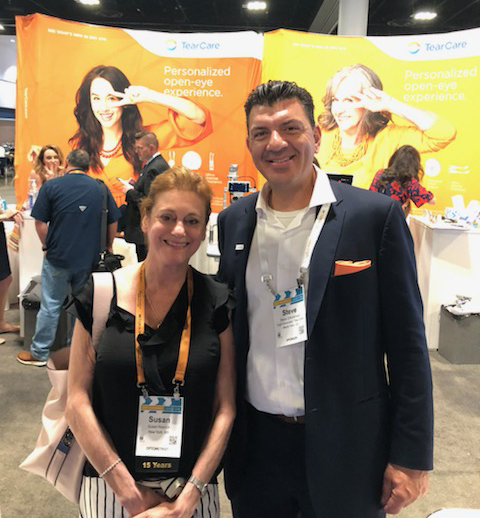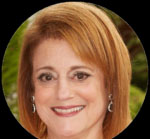
Dr. Resnick with Steve D’Ambrosio of Sight Sciences. Dr. Resick says vendor reps can help an OD educate their staff about new products and treatments, serving as adjunct team members in the practice.
By Susan Resnick, OD, FAAO, FSLS
Feb. 2, 2022
Forging mutually beneficial relationships with vendors has always been instrumental to the success of our practice. We rely on them to not only supply us with the services and materials we need in order to provide state of the art care, but also to achieve our clinical and financial goals. Our vendors actively support us in our acquisition and maintenance of new technology and instrumentation, pharmaceutical sampling and prescribing guidance, contact lens diagnostics and inventory, optical curating, staff education and training and business management.
Here are three key steps that have helped us build the well-leveraged vendor relationships that drive our clinical success and promote our practice profitability.
Cultivate Rep Relationships
The strength of any successful and enduring relationship lies in its value to both parties. This is certainly at the core of professional relationships with vendor representatives. Open and ongoing communication, whether directly through the doctors or via the office managers, ensures we receive timely service. In turn, our reps are granted the flexible, yet structured, access to our team which is necessary for effectively conducting their business.
We begin by orienting our reps to our practice’s clinical focus, office culture and business protocols. We then establish mutually agreed upon “ground rules” for their welcomed involvement. These include frequency of scheduled visits, with whom they will be meeting, and when “drop-ins” are acceptable. In general, our doctors will have scheduled meetings on a quarterly basis. There are monthly encounters with select staff to take inventory, provide samples, or just “check in.” There is mutual respect of time on the part of both parties, and all involved do their best to honor meeting times. Finally, we take care to ensure business and patient privacy.
Involve Reps as Team Members
Taking the relationship to the next level, our vendor representatives are encouraged to play an active role in our practice logistics. This involves ongoing advising, education and training of our team on administrative, clinical and financial aspects of their specific products and services. The time we allocate to a specific vendor is directly proportional to the depth and breadth of their training platforms, consultative initiatives and marketing programs.
A few examples include Sight Sciences whose reps fully educate our staff on the clinical aspects and function of TearCare, RVL pharmaceuticals whose reps ensure we are well sampled with Upneeq and supplied with patient education assets, and Alcon’s team, which not only ensures we have the diagnostic contact lenses we need, but also fully trains and implements their MARLO patient communications platform within our practice.
Through the generosity of their time and resources, these and many other vendors conduct well-attended “lunch and learns” with our staff to ensure full engagement and participation in the training process. Setting aside this dedicated time, where all staff members and doctors are present, accomplishes three important things. First, it sends a message to our team that this is an important area of practice focus. Second, it provides uninterrupted time for the training and to answer questions and address concerns. And perhaps most importantly, the social interaction generates staff enthusiasm, positively impacting team morale.
Develop the Business Partnerships
One of the most challenging aspects of independent optometry is negotiating wholesale pricing. Ideally, this process should occur annually. Given the numerous vendors with whom ECPs engage, it can be extremely time consuming as well as stressful. It was for these reasons, that almost two decades ago, our practice joined Vision Source.
Joining a doctor alliance, such as IDOC, PECAA, PERC, Vision Source, or another, is an excellent way for independent ODs to benefit from the favorable pricing afforded to members as a result of group buying power. Savings occur not only from pricing differentials, but also as a result of rebates and growth incentives.
Other Articles to Explore
Closing out 2021, our practice’s combined rebates from all our Vision Source participating vendors amounted to almost $60,000. And even better, as we begin a new year, membership has once again removed the burden of the annual negotiating process.
Through our membership in the Vision Source network, we have successfully implemented at least one new “profit center” a year. Leveraging the substantial savings off list price on equipment and devices (typically 15-25 percent), our profit centers net us a minimum of $20,000 per year. This year we invested in three new devices from Topcon including an OCT, visual field device and topographer with axial length measuring capability. These instruments will deepen our clinical diagnostic capabilities and/or improve testing efficiency.
Through careful selection and vetting of potential vendors, developing close mutual professional relationships and, perhaps, joining a doctor alliance, independent practitioners do not have to go it alone. Improved patient care, a more engaged staff, and more effective marketing and implementation of services, are just a few of the positive outcomes of successful vendor partnerships.
 Susan Resnick, OD, FAAO, FSLS, is president of Drs. Farkas, Kassalow, Resnick & Associates in New York City. To contact her: sresnick525@gmail.com
Susan Resnick, OD, FAAO, FSLS, is president of Drs. Farkas, Kassalow, Resnick & Associates in New York City. To contact her: sresnick525@gmail.com





















